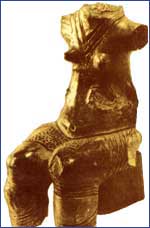
Archaeological Sites
The first human settlements on Belgrade soil developed as far back as 7000 years ago. This is borne out by numerous archaeological sites with material evidence, ranging from the culture of the Old Stone Age and other prehistoric cultures, to the Middle Ages. The sites are not arranged for visitors, and the material remnants are for the most part kept in the National Museum.
Vinča, 14 km away from Belgrade on the way to Grocka, is a prehistoric tell on the very bank of the Danube, with the remnants of the material culture of the prehistoric man (the Neolithic plastics). In the caves in Bele vode there were found skeletons of the Neanderthal man. The most widespread culture in the territory of Europe at the time is called after the site in Vinča.
In the territory of Grocka there are the sites: Agino brdo (the Neolithic), Dubočaj, and Brestovik (the Roman period). In the territory of Surčin, nearby Jakovo, there is Kormadin, where the artefacts from the Late Neolithic were found. On the way to Avala, in Šuplja stena, there were discovered the prehistoric mining pits and, in Mt. Avala, a medieval stronghold made of stone, the hill-fort Žrnov.
In the territories of Karaburma and Rospi ćuprija, there were dug quite well preserved Celtic tombs. The Roman thermae found in the University Park on Studentski trg (Students’ Square), are the remnants of a Roman civilian settlement. The remnants of a Roman settlement were also discovered in the Lower Town on Kalemegdan – Mithra’s holy shrine with the sacrificial altar and small thermae.

